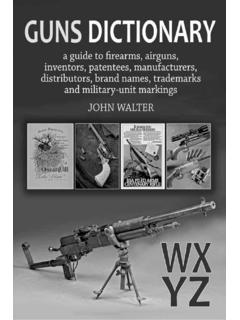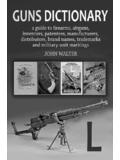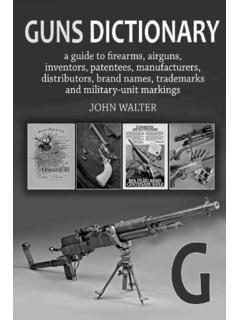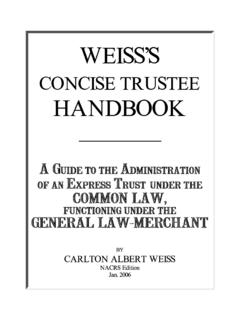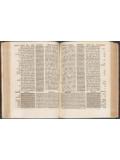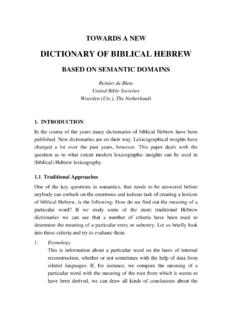Transcription of PAGE A2 - archivingindustry.com
1 GUNS dictionary : PAGE A1 PAGE A2 : GUNS DICTIONARYa Found on components for the Kar. 98k made during the Second World War by N hmatag N hmaschinenteile AG of Dresden, A headstamp found on rimfire and possibly other cartridges made by the American Cartridge Company for sale in North America by Gamble Stores. It may be accompanied by Airway .A in a seven point star. A mark applied by an inspector working in the Lithgow small arms factory in New South Wales, Australia. Superseded by MA ; British military inspectors marks .A often cursive, beneath a crown. Found on Belgian weapons: the mark of King Albert (1909-34). Cyphers, imperial and royal .A in a cross. A trademark found on Gem-type airguns sold in Britain by Adolph Arbenz of apparently above an inverted 2 forming the crossbar of the letter. An Arabic mark applied by the Iraqi Republican sometimes with an owl trademark.
2 Found on small Browning type autoloading pistols made by Gaspar Arizaga of Eibar, often encircled. A headstamp identifier associated with the American Metallic Cartridge Found in imperial-era German unit markings, applied by the field artillery regiments or Feldartillerie-Regimenter under the regulations of 1877 and 1909. A typical mark reads , for the 25th weapon issued to the 5th battery of Feldartillerie-Regiment Nr. 5. The following units existed in 1914: Prussian regiments 1 11, 14 27, 30, 31, 33 47, 50 63, 66, 67, 69 76 and 79 84; Saxon regiments 12, 28, 32, 48, 64, 68, 77 and 78; W rttemberg regiments 13, 29, 49 and beneath a crown. This mark will be found in the headstamps of Danish military ammunition made by the Ammunitionsarsenalet in Copenhagen in 1950 2. See also AMA .AA monogram. A trademark found on automatic pistols made by Azanza y Arrizabalaga of Eibar, monogram, S -shape.
3 Found on guns made by F brica de Armas SA Alkartasuna of Guernica, Applied to military stores including .30 Springfield rifles and .45 M1911A1 Government Model pistols refurbished by Augusta Arsenal, monogram. A trademark associated with handguns made by Azanza y Arrizabalaga of Eibar, usually accompanied by a knight s helm. A trademark found on guns made by A. Aldazabal of Eibar, DIRECTORY: A AZULLast update: May 2018 GUNS dictionary : PAGE A3 AAA Found on a Spanish Browning-type automatic pistol made by A. Aldazabal of Eibar, Guipuzcoa, in several patterns: (1) ; six rounds, hammer fired. Some guns may be marked Model 1919 . (2) ; seven rounds, hammer fired. Often marked Model 1916 .AA Auto Pistol Found on the Browning-pattern and semi-automatic pistols made by Azanza y Arrizabalaga of Eibar, Guipuzcoa, Found on guns made in Eibar, Spain, by Azanza y monogram.
4 A trademark associated with the products of the American Arms Company of Boston, or Found in the headstamps of the products of the American Ammunition Co. of Oak Park, Chicago and Muscatine, or Associated with a Suicide Special revolver made by the Ryan Pistol Mfg. Co. of Springfield, Massachusetts, , in the late nineteenth superimposition monogram, with A , A and C of near-equal dominance. A mark found on the grips of revolvers made by the American Arms Corporation ArmaLite .A-Airway Air way .aak Found on pistols, rifles, machine guns and components made during the German occupation of Czechoslovakia by Waffenwerke Br nn AG of Prague. They date from the Second World Applied to rifles and small-arms, including rifles and carbines, inspected by Applied under the 1909 regulations, was used by the German field-artillery brigades (Feldartillerie-Brigaden); signified the 25th weapon issued to 10.
5 Used by arms inspector A. monogram. A trademark associated with the products of Bersaluce Arieto Aurtena y Cia of Eibar, Spain (actually BA ).aba A trademark found on barrel insert components made for Erma by Alig & Baumg rtel of Aschaffenburg, sometimes as a monogram with B dominant. Used prior to c. 1920 by August Blatt of Suhl in Th ringen. [Should this be ABS ?]Abadie A gunmaker, possibly an employee of the Nagant brothers. His 1874 patent loading gate is found on some Nagant revolvers made in the period 1878 90. Opening the gate allows the trigger to rotate the cylinder without needing to overcome the pressure of the mainspring, the hammer being disconnected. This facilitates ejecting spent cases or reloading the gun. (Note: Abadie is often mistakenly identified as a Portuguese army officer, as the Syst me Abadie is found on Serbian guns in addition to Portuguese issue.)
6 Abakan A codename applied to a competition held in the USSR (subsequently in Russia) to find a replacement for the venerable Kalashnikov assault rifle. The trails apparently began in the late 1980s and continued to 1995 or later. PAGE A4 : GUNS DICTIONARYThe name has often been (mistakenly) applied specifically to the Nikonov or NSM and Abas Major These names were applied to a .177 calibre spring-air pistol designed in 1944 5 by , and Brown, protected by British Patent 604,411, and made in Birmingham by Brown & Sons from 1947 until the early 1950s. The Abas Major was cocked by pulling down on the trigger guard and loaded through a tap at the rear of the spring Alig & Baumg rtel .ABB A mark used by arms inspector , usually as The Abbey . Found on shotgun cartridges marketed by Smith & Sons of Birmingham. They seem to have been borne headstamps identifying Nobel Industries or English gunmaker Edmund Abbey of Newport Pagnell, Buckinghamshire, was listed in High Street in 1852 and in nearby John Street from 1862 until about 1870.
7 His marks have been reported on self cocking pepperboxes and cap lock Abbey & Company was a partnership of Frederick J. Abbey and Thomas H. Foster, who made cap lock sporting guns (including rifles, shotguns and pistols) plus break-action cartridge shotguns from 43 South Clark Street, Chicago, Illinois, The shotgun patented by Frederick J. Abbey (see below) seems to have been made until the late 1870s, when the company was sold to E. Thomas, Frederick J. Abbey, a gunmaker/inventor of 43 South Clark Street, Chicago, Illinois, was active in 1853 79. He received Patent 114081 on 25th April 1871 to protect a shotgun style breech locked by two lateral pins entering a recess in the barrel block. Frederick Abbey made cap lock target rifles before becoming a founding partner of Abbey & Company (see above).Abbey George T. Abbey, working in 1858 74 in Chicago, Illinois, , designed a breech loading shotgun in the late 1860s, receiving patent 87814 on 16th March 1869.
8 A vertical post lock in the rear of the action was operated either by an underlever or by a catch ahead of the trigger guard. The underlever lock comprised lugs on the bolt head, while the catch relied on a pin pushed up into the barrel block. There were also two lugs beneath the barrel. George Abbey is believed to have been the son of Frederick J. Gun & Ammunition Company [ ]: Goring upon Thames and Wallingford, Oxfordshire; and Reading, Berkshire, England. This was a trading style of what later became the Abbey Supply Company, adopted in 1974. The company specialised in gun lubricants, but also imported Chinese-made airguns and Danish Pallet airgun ammunition into Britain. The move to Mill Lane, Wallingford took place in 1976, and to Great Knollys Street in Reading in 1981. Operations ceased in the early Improved Chilled Shot Co. Ltd [ ]; Newcastle-upon-Tyne, Northumberland, England.
9 This business advertised itself as manufacturer GUNS dictionary : PAGE A5of Improved Chilled Shot and Hard and Patent Shot as well as the loader of Abbeyrite shotgun cartridges. An advertisement in the 1910 edition of W. W. Greener s book The Gun and Its Development noted that Abbey was then supplying more than twenty sizes of shot, ranging from LC to D respectively six and 2600 to the ounce. It is suspected that Greener had something to do with the Abbey company (the book notes that Exporters [should] apply to Greener [for prices]), but the operations were acquired by Eley Brothers shortly before the First World War A name associated with shotgun cartridges supplied to the Gun Trade prior to 1913 or 1914 ( wholesale only ) by the Abbey Improved Shot Co. Found in the headstamps of cartridges made in West Haven, Connecticut, , by the American Buckle & Cartridge The essence of this breechloading system, patented in Switzerland in 1851 and often erroneously listed as Abezz or d Abezz , was a chamber which could be swung out to the right of the frame as the underlever was moved to the left.
10 The lever was usually bent to follow the contours of the trigger guard. Guns of this pattern were often converted from Swiss Federal cap-lock short rifles; sporting guns had special butts, set triggers, and greater attention to detail, but the lack of a positive breech-locking system limited the life of the Abegg system to less than a & Fitch The Abercrombie & Fitch Company was founded in 1892 by Ezra H. Fitch (1865 1930) and David T. Abercrombie (1867 1931) to handle equipment for explorers, huntsmen, fishermen and sportsmen, including guns and ammunition. Trading was undertaken from 53 57 West 36th Street, New York, until the Abercrombie & Fitch Building was erected in 1916 17 on the corner of Madison Avenue and 45th Street. Prior to the emergence of Stoeger as the sole agency, Abercrombie & Fitch distributed refurbished Swiss style Lugers; these were apparently assembled in Germany, but exported to the by H mmerli.


